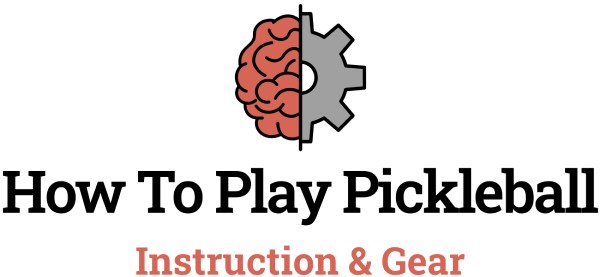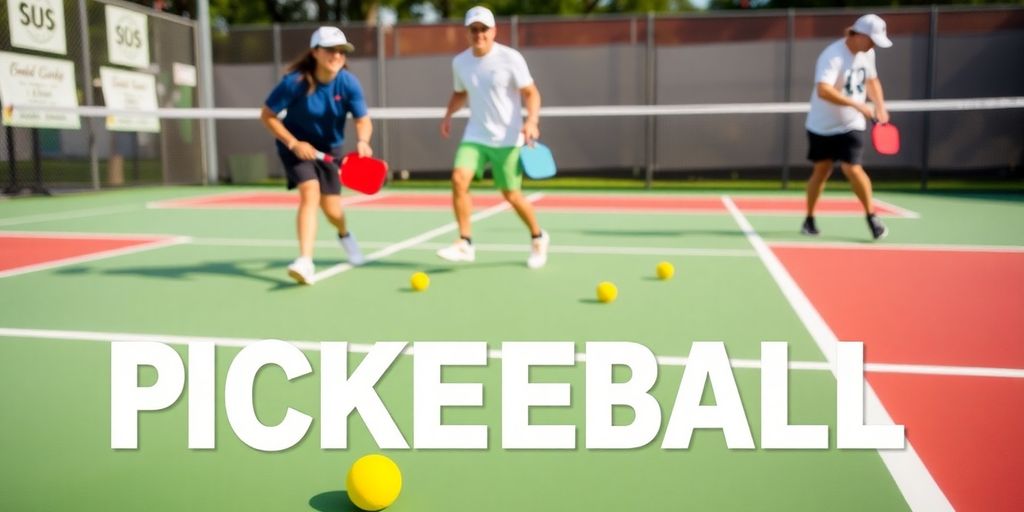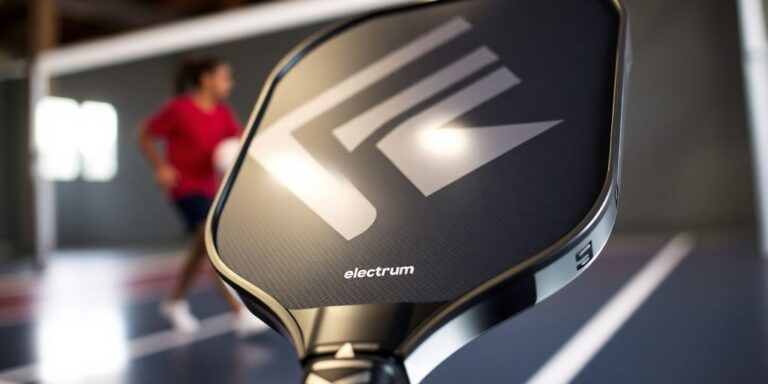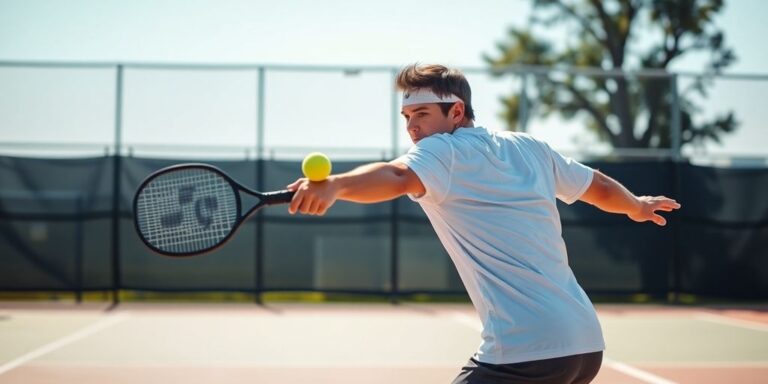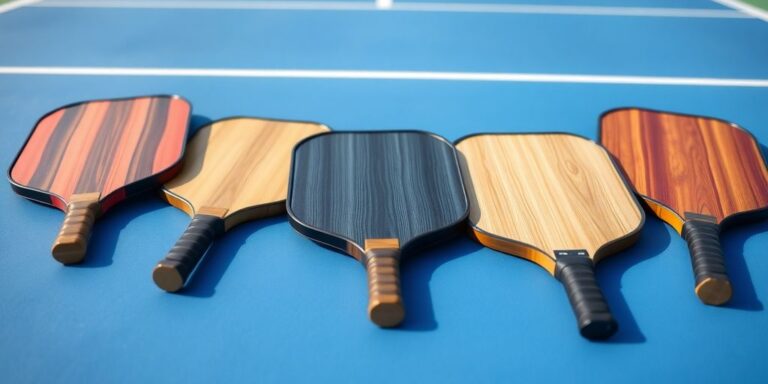If you’re looking to thrive in pickleball, understanding the right strategies and having the right gear is essential. Whether you’re just starting out or trying to take your game to another level, this guide will help you navigate the important aspects of pickleball, from tactics to equipment. Let’s dive into how you can improve your game and enjoy every moment on the court!
Key Takeaways
- Focus on strategy to outsmart your opponents, not just raw skill.
- Choose the right paddle and shoes to match your playing style.
- Master basic shots like the dink for better control of the game.
- Avoid common mistakes like rushing the net or over-hitting.
- Communicate effectively with your partner in doubles to enhance teamwork.
Why Strategy Matters In Pickleball?
Raw talent is great, but in pickleball, a solid plan can really set you apart. It’s not just about hitting the ball hard; it’s about thinking smart and playing smarter. A good pickleball doubles strategy or singles strategy can turn the game into a mental challenge, letting you use what your opponent does against them. It’s about making smart choices, being in the right spot, and hitting the ball with a purpose. Forget flashy moves; it’s about reading the court, changing your game as needed, and always being one step ahead.
Understanding the Mental Game
Pickleball isn’t just physical; it’s a real mental workout. You’ve got to think about every shot, predict what your opponent will do, and adjust your plan on the fly. It’s like a chess match, but with paddles and a wiffle ball. Being able to stay calm under pressure and make smart decisions is what separates the good players from the great ones. It’s about more than just hitting the ball; it’s about outsmarting your opponent.
Utilizing Opponent’s Weaknesses
Every player has weak spots. Maybe they struggle with backhands, or they aren’t great at the net. The key is to figure out what those weaknesses are and then exploit them. If you know they hate dinking, keep dinking! Make them play your game, not theirs. This is where effective doubles strategy comes into play, especially when you can isolate a weaker player.
The Importance of Positioning
Where you stand on the court matters a ton. Being in the right spot can give you a huge advantage. For example, controlling the net lets you dictate the pace and angle of the game. Good positioning also means you’re ready to react to whatever your opponent throws at you. It’s about being proactive, not reactive. Think of it like this:
- Always be ready to move.
- Anticipate where the ball is going.
- Control the non-volley zone.
Positioning is everything. If you’re not in the right spot, you’re already at a disadvantage. It’s about court awareness and knowing where you need to be to make the next play.
Enhancing Your Game With The Right Equipment
Okay, so you’re getting into pickleball, or maybe you’re already hooked. Either way, let’s talk gear. It’s not just about looking the part; the right equipment can actually make a difference in your game. I remember when I first started, I was using this old, beat-up paddle, and I couldn’t figure out why I wasn’t improving. Then I upgraded, and wow, what a change!
Choosing the Right Paddle
The paddle is your primary tool, so choosing wisely is important. There are so many options out there, it can be overwhelming. You’ve got different materials like graphite, composite, and wood. Graphite paddles are usually lighter and offer more control, while composite paddles can give you more power. Wood paddles are the most basic and are good for beginners just starting out. Consider your playing style. Do you like to smash the ball, or are you more of a finesse player? This will help you decide what kind of paddle to get. Also, think about the grip size. A grip that’s too big or too small can mess with your control.
Here’s a quick guide:
- Beginner: Look for a lightweight composite or wood paddle with a medium grip.
- Intermediate: Graphite or composite paddle with a grip that fits your hand comfortably. Experiment with different shapes and weights.
- Advanced: Consider a custom pickleball paddle to match your specific needs and playing style.
Importance of Footwear
Don’t underestimate the importance of good shoes! I learned this the hard way after twisting my ankle one time. Court shoes are designed to provide lateral support, which is super important for those quick side-to-side movements you make in pickleball. Running shoes aren’t going to cut it; they don’t offer enough stability. Look for shoes with good traction and cushioning. Your feet will thank you, and you’ll be less likely to get injured. Trust me, investing in a decent pair of court shoes is worth it.
- Lateral Support: Prevents ankle rolls during quick movements.
- Traction: Ensures a firm grip on the court surface.
- Cushioning: Absorbs impact and reduces stress on joints.
Selecting the Best Balls
Pickleballs aren’t all created equal. There are indoor and outdoor balls, and they play differently. Outdoor balls are heavier and have smaller holes to withstand wind, while indoor balls are lighter and have larger holes for better flight indoors. The color matters too! Bright colors like yellow or orange are easier to see. I usually keep a mix of indoor and outdoor balls in my bag so I’m prepared for anything. Also, balls wear out over time, so don’t be afraid to replace them when they start to get soft or cracked. Using quality pickleball paddles and balls can really improve your game.
Choosing the right equipment is more than just a matter of preference; it’s about optimizing your performance and preventing injuries. Take the time to research different options and find what works best for you. It might take some trial and error, but it’s worth it in the long run.
Key Pickleball Strategies For Beginners
For those just getting into pickleball, it’s easy to get caught up in trying to smash every ball. But trust me, that’s not the way to go, at least not at first. It’s way more important to build a solid base with some key strategies. Forget the fancy stuff for now; let’s nail the basics.
Mastering the Dink Shot
The dink shot is your new best friend. Seriously. It’s a soft shot that lands in the non-volley zone (the kitchen). Mastering the dink shot pickleball dink lets you control the game’s pace and forces your opponents to hit upwards, which gives you an advantage. Think of it as setting the stage for your attack. It’s not glamorous, but it’s incredibly effective.
Effective Communication in Doubles Play
If you’re playing doubles, talking to your partner is super important. You need to be on the same page about who’s covering what. Develop some simple signals or calls to avoid confusion. For example:
- "Yours!" means you’re taking the shot.
- "Switch!" means you’re changing positions.
- A thumbs-up means you’re moving up to the net.
Good communication can make a huge difference in doubles pickleball strategy, turning potential chaos into coordinated teamwork.
Consistency Over Power
I know, I know, hitting the ball as hard as you can seems appealing. But in pickleball, especially when you’re starting out, consistency beats power every time. It’s better to get the ball in play than to try for a killer shot that goes out. Focus on keeping the ball in the court, and let your opponents make the mistakes. Aim for placement and control, not just raw power. Think of it this way:
Pickleball isn’t about who can hit the hardest; it’s about who can keep the ball in play the longest. Patience and placement will win you more games than brute force ever will.
Common Mistakes To Avoid In Pickleball Strategy

In pickleball, it’s easy to get caught up in the excitement and make strategic errors that can cost you the game. Knowing what not to do is just as important as knowing what to do. Let’s look at some common pitfalls.
Rushing the Net Prematurely
A lot of players make the mistake of charging the net too early, without setting up the shot first. This can leave you vulnerable to passing shots or lobs right over your head. Instead, make sure your return shot is tough for your opponent to handle before you advance. Think about hitting a deep shot to their backhand or placing it near the edge of the court. This forces a weaker return and gives you a better chance to control the point. Understanding the kitchen rules is key to avoiding this mistake.
Overusing Power Shots
It can be tempting to just smash the ball every time, especially if you’ve got a strong swing. But constantly relying on power shots can backfire. It often leads to unforced errors and gives your opponent opportunities to capitalize on your mistakes. It’s better to mix things up. Use a variety of shots, including dinks, drops, and angled shots, to keep your opponent guessing and off balance. Consistency and placement are often more effective than pure power. Think about developing a consistent serve instead of always trying to overpower it.
Ignoring Defensive Play
Many players focus too much on offense and neglect their defense. A strong defense is about more than just blocking shots; it’s about resetting the point and creating opportunities to regain control.
Don’t underestimate the importance of defensive strategies like resetting the point with a soft shot or using a strategic lob to buy yourself time. Good defense can frustrate your opponents and force them into making errors.
Here are some defensive tactics:
- Resetting the Point: Use soft shots to neutralize aggressive plays.
- Maintaining Position: Stay balanced and ready to react to any shot.
- Strategic Lobbing: Force opponents back, disrupting their rhythm.
Choosing the right pickleball paddle covers can also indirectly help your defensive game by ensuring your paddle is always in top condition.
Pickleball Strategy Singles & Doubles
Pickleball isn’t just about hitting the ball; it’s about how you hit it and where. The strategies you use will differ a lot whether you’re playing singles or doubles. Let’s break down the key differences so you can up your game, no matter which you prefer.
Singles Strategy Essentials
Singles pickleball is a real test of your endurance and court awareness. It’s all on you to cover the entire court, so your strategy needs to reflect that. Here’s the deal:
- Court Coverage is Key: You’ve got to be quick and anticipate where your opponent is going to hit the ball. Always be ready to move.
- Deep Shots Matter: Pushing your opponent back with deep shots gives you control of the rally. It limits their ability to attack and opens up opportunities for you.
- Target Weaknesses: Figure out if your opponent struggles more with their forehand or backhand, and then exploit that weakness. Make them move to their less comfortable side.
Singles is a grind. It’s about wearing down your opponent and capitalizing on their mistakes. Don’t go for flashy shots; focus on consistency and smart placement.
Doubles Coordination Techniques
Doubles is a whole different ball game. It’s about teamwork, communication, and covering the court together. Here’s how to make it work:
- Dink it to Win it: The kitchen line is where doubles is won or lost. Use dinks to control the pace and create opportunities for attacks. Avoid popping the ball up high, or you’ll get smashed.
- Stay Together: Stick close to your partner near the kitchen line. This minimizes gaps and makes it easier to defend against quick shots. Advancing to the kitchen line together is a key strategy.
- Communicate: Talk to your partner! Call out shots, let them know where you’re moving, and coordinate who’s taking which ball. Communication is key to avoiding confusion and covering the court effectively.
Exploiting Opponent’s Weaknesses
Whether you’re playing singles or doubles, knowing your opponents’ weaknesses is a huge advantage. Here’s how to use that knowledge to your benefit:
- Observe: Pay attention during warm-ups and the first few points to see if your opponents have any obvious weaknesses. Do they struggle with backhands? Are they slow to move to the non-volley zone? Do they have trouble with lobs?
- Target: Once you’ve identified a weakness, target it consistently. Don’t let them off the hook. Keep hitting the ball to their weak spot until they prove they can handle it.
- Mix it Up: Don’t be predictable. If you keep hitting the ball to the same spot, they’ll eventually adjust. Mix in some shots to their strengths to keep them guessing. Finding a pickleball partner who can help you identify these weaknesses is also a great strategy.
| Aspect | Singles | Doubles |
|---|---|---|
| Court Coverage | Individual responsibility | Shared responsibility with partner |
| Communication | Self-reliance | Essential with partner |
| Pace | Generally faster, longer rallies | More tactical, shorter rallies |
| Key Skills | Endurance, quick reflexes, court sense | Teamwork, shot placement, anticipation |
Serving Tips For Effective Play

Developing a Consistent Serve
The serve is your opening act; make it count. A consistent serve minimizes errors and sets the tone for the entire point. To achieve this, focus on developing a smooth, repeatable motion. Practice making clean, accurate contact with the ball, using the same toss and swing each time. Think of it like perfecting your signature – the more you practice, the more reliable it becomes. This is where you can really start to master the serve.
Aiming for Precision Over Power
While a powerful serve might occasionally intimidate an opponent, precision is often the more effective strategy. Instead of trying to blast the ball as hard as you can, focus on placement.
- Target deep corners to push your opponent back.
- Aim for their weaker backhand side to force an uncomfortable return.
- In doubles, try pulling opponents wide to open up angles for your partner.
In singles, a deep serve keeps your rival pinned at the baseline, reducing their ability to rush the net. Remember, it’s about strategy, not just strength. Think of it as playing chess – every move should have a purpose. This is how you can serve in pickleball.
Using Spin to Your Advantage
Spin adds another layer of complexity to your serve, making it unpredictable and harder to return effectively. Experiment with different types of spin to see what works best for you.
- Topspin can create serves that dip quickly and bounce high, forcing your opponent to hit upward.
- Sidespin can make the ball veer sharply upon landing, pulling your opponent off balance.
- Backspin can create a lower bounce, making it harder to attack.
Mastering spin takes time and practice, but it can be a game-changer. Don’t be afraid to experiment and see what kind of serves give your opponents the most trouble. The more unpredictable you are, the harder it will be for them to anticipate your shots.
Defensive Strategies To Control The Game
Resetting the Point
Sometimes, you’re on the back foot. Your opponent is hammering shots, and you’re just trying to stay alive. That’s when resetting the point becomes super important. The goal is to slow the game down and regain control. How do you do it? Soft shots, especially dinks, are your best friend. By gently placing the ball into the kitchen, you force your opponent to hit upwards, neutralizing their power advantage. It’s about turning their strength into a weakness. This is a great way to practice defensive lob.
Maintaining Position
Where you stand on the court matters, a lot. You can’t just stand flat-footed and expect to react to everything. A good defensive stance involves a low center of gravity, with your knees slightly bent. This allows for quick movements in any direction. In doubles, it’s about staying in sync with your partner, covering the court effectively. In singles, it’s about staying centered, ready to pounce on any opportunity. Think of it like a coiled spring, ready to unleash when the moment is right. It’s important to understand the rules of pickleball to maintain proper positioning.
Strategic Lobbing
Lobbing isn’t just for show; it’s a powerful defensive tool when used correctly. A well-placed lob can completely disrupt your opponent’s momentum, especially if they’re aggressive at the net. By forcing them to retreat, you buy yourself valuable time to reset your position and prepare for the next shot. It’s a calculated risk, but the reward can be significant. Just make sure your lob is high enough to clear their reach, but not so high that it gives them an easy overhead smash. It’s a delicate balance. You can also use advanced pickleball techniques to improve your lobbing.
Think of defense as a way to frustrate your opponent. It’s not about hitting flashy shots or making incredible saves. It’s about making them work for every point, forcing errors, and slowly chipping away at their confidence. A solid defense can win you games, even when your offense isn’t firing on all cylinders.
To keep control of the game, using smart defensive strategies is key. These tactics can help your team stay strong and make it harder for the other side to score. Want to learn more about how to improve your game? Visit our website for tips and tricks that can take your skills to the next level!
Wrap-Up: Gear Up and Get Playing!
So there you have it! If you want to step up your pickleball game, it’s all about the right gear and smart strategies. Picking the right paddle can really change how you play, and knowing when to use certain shots can make a big difference. Don’t forget to communicate with your partner in doubles and keep an eye on your opponent’s weaknesses. Remember, practice makes perfect, so get out there, have fun, and keep improving. Whether you’re playing singles or doubles, the key is to enjoy the game and keep learning. Happy playing!
Frequently Asked Questions
What is the most important strategy in pickleball?
The key strategy in pickleball is to control the net by staying close to the kitchen line. This helps you take charge of the game and respond quickly to your opponent’s shots, allowing you to make precise volleys.
How can I quickly improve my pickleball skills?
To get better at pickleball fast, focus on practicing basic shots like the dink, work on your serves for consistency, and improve your footwork. Regular practice of these basics will build a strong foundation for your game.
What does stacking mean in doubles pickleball?
Stacking in doubles means positioning players so they can play to their strengths, usually keeping their stronger shots in the middle of the court. This helps the team cover more ground and be more effective.
Why is communication important in doubles play?
Communication is crucial in doubles pickleball because it helps avoid confusion and ensures that both players know who will take each shot, making the game flow better.
What are some tips for serving effectively in pickleball?
To serve well in pickleball, focus on being consistent, aim for accuracy rather than just power, and try using spin to make your serves harder to return.
What should I avoid to improve my pickleball strategy?
To improve your pickleball strategy, avoid rushing to the net too soon, overusing power shots, and ignoring defensive plays. Timing and smart decision-making are essential.
